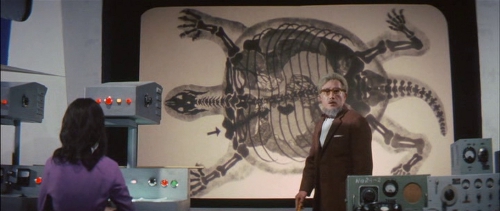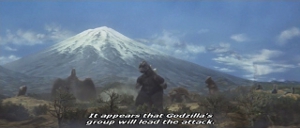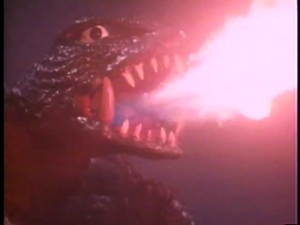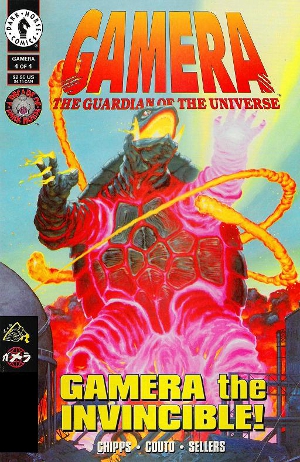Tag Archives: Daikaiju
Gamera vs. Jiger (1970)

This, the sixth Gamera film, (released in the U.S. as Gamera vs. Monster X) is really the third part in a Pentalogy that ends the series, all following the same basic outline. A New Monster arises, Gamera loses his first fight, and spends half the movie down for the count as the Military/Scientific/Industrial Complex fails to combat the latest kaiju threat. A pair of Annoying Kids (one Japanese, on Token Anglo), Designated as Our Duel Protagonists, take it upon themselves to deal with a human-sized problem, and their plucky spirits rouse Gamera, Friend to All Children, from his mid-movie stupor. He wins the Climactic Battle as the Kids watch from Minimum Safe Distance, ruining the fun for everyone with their high-pitched color commentary. Cue credits.
With this one, I can’t even escape the opening credits without deducting points for stock-footage. Someone’s mom obviously told them to “put their best foot forward,” but I doubt “reuse fight scenes from the previous five films” is what she really meant. In fairness, the is the last we’ll see of previous battles…though not, as I’ll discuss later, the last time we’ll see stock footage. However, Gamera vs. Jiger can still boast the least amount of stock footage in any Gamera film since Gamera vs. Gaos. Marvel at that for a moment. It’s almost as if Team Gamera enjoyed a budget increase after their success with vs. Viras and vs. Guiron. If so, it only accelerated Daiei Studios collapse into bankruptcy. But we’ve one more film before that happens. Continue reading Gamera vs. Jiger (1970)
Gamera vs. Guiron (1969)
Pacific Rim (2013)
Destroy All Monsters (1968)

For G-fans, this is the Big One, the culmination of all that came before. It’s easy to see why since Kaijû sôshingeki (“Charge” or “Invasion” or “Attack of the Monsters“; take your pick) hits the ground running with none of the drawn-out build-up we’ve come to expect from these flicks…especially those directed by Ishiro Honda. By the eleven minute-mark, Godzilla’s nuking the UN and his monstrous colleagues are reducing other major cities to scrap. By the end of the film, ten monsters engage the twice-defeated (yet inexplicably popular) King Ghidorah in a no-holds-barred brawl in the shadow of Mt. Fuji, which became legendary before the film’s premiere.
So the number one reason cited for out-and-out loving Destroy All Monsters is totally valid. Here, you really can get more monsters for your money and the scope of that Climactic Battle is mind-bending, both as a piece of cinema and as a technical landmark in film making history. Ten monsters, most of them actors in costumes, the rest puppets, all requiring some manner of off-screen puppeteers to keep up the illusion. It was a logistical nightmare of actors and wires and animatronics, all under hot lights, sixteen hours a day…but thanks to the magic of editing and shot composition, its made not only beautiful, but enduringly awesome.
For many G-fans, that fight alone ensures this film can do no wrong. For others, Destroy All Monsters can do no wrong because it was their introduction to Godzilla and his universe. A certain generation (the one right ahead of mine, in fact) grew up seeing this film on network TV, where it played with varying degrees of regularity until the 1980s. This was back in the days when there were only three networks and they bought up catalogs of cheap, old films to shore up their schedules. Continue reading Destroy All Monsters (1968)
It Came from Beneath the Sea (1955)

Columbia Pictures should give us all hope that we can rise above our station in life. This little Poverty Row studio, which made a name for itself producing comedy shorts in the 30s (including The Three Stooges’ most famous works) had, by the mid-50s, replaced RKO as a member of the Big Studios Club. With everything from Superman cartoons to Marlon Brando Oscar winners in their catalog, its seems only natural Columbia would try to field a giant monster movie for 1955.
You have to give them credit for going about it the right way – hiring two of Them!‘s writers and a man (now) more famous than either of ’em – the stop-motion animator behind The Beast from 20,000 Fathoms, Ray Harryhausen. If this film’s remembered for anything, it’s remembered for Harryhausen’s effects. This is the mid-point between his career-defining turn in Beast and the next year’s State of the Art showcase, Earth vs. The Flying Saucers. But Art doesn’t come cheap, so I shouldn’t be surprised all of Harryhausen’s contribution’s are crammed into the film’s last 15 minutes. I was. Unpleasantly so. But I shouldn’t have been.
It Came from Beneath the Sea fired its first warning shot right off, beginning with a Bad Movie Double Down: droning narration played over military stock footage. It’s 1955, after all, one year after the successful launch of the U.S. Navy’s first nuclear submarine, the U.S.S. Nautilus. This is meant to make the move Relevant to a distracted audience who may not give a crap about anything outside their pathetic little lives. It ends up pointing towards a theme that might’ve ameliorated the many failings of this film, had anyone cared to play that theme out. As Our Humble Narrator says,
“The mind of man had thought of everything – except that which was beyond his comprehension!” Continue reading It Came from Beneath the Sea (1955)
Gamera vs. Viras (1968)
2-Headed Shark Attack (2012)
War of the Gargantuas (1966)

Hold on to your butts, people. This is a weird one, with an even weirder history than your average cult classic. Produced in association with Henry G. Saperstein’s United Pictures, War of the Gargantuas took four years to get to the American drive-in circuit, where it premiered on a double bill with Godzilla vs. Monster Zero. Like that film, Gargantuas features a Token American in the lead (Russ Tamblyn), supported by two instantly recognizable (to me at least) Honda Repertoire Company vets (Kenji Sahara and Kumi Mizuno). But unlike Monster Zero, Gargantuas is a much more grounded, much more traditional kaiju flick – arguably more so than its almost-prequel, Frankenstein Conquers the World.
That film (for anyone who doesn’t know/remember) concerned a team of scientists who happened upon a street urchin who once devoured the immortal heart of Frankenstein’s monster, irradiated by a nuclear blast after Nazi scientists shipped it to a Hiroshima during the last days of World War II. Said devouring ballooned the street urchin – which everyone pretty much just started calling “Frankenstein” – up to Ultraman-ish proportions, bringing him into inevitable conflict with the Japan’s military Self Defense Forces and roving, wild dinosaur population. Continue reading War of the Gargantuas (1966)
Gamera vs. Gaos (1967)

This is the exact midpoint of Gamera’s original (or “Showa Era”) film series. Not chronologically, or in any other terms material, but in terms of tone. This is the point where everyone at Gamera’s home studio, Daiei Film, gave up on the daikaiju genre as anything other than a cash cow. You can barely blame them. By 1967, the writing was on the wall and it said, “the only people stupid enough to abandon their TVs and visit some run-down, overcrowded, food-and-drink-stained movie theater are children.” Film as a whole suffered, but few suffered more than our favorite flying turtle, who would go on to star in some of the most notoriously bad films in daikaiju eiga as the seventies rose up to choke us all down with mediocrity, bad music, and even worse clothing.
Things didn’t have to be this way, but the makers of mid-60s Japanese cinema made the same mistake their American counterparts so often make and assumed (A) kids were the only ones watching their films and (B) kids were stupid. But there’s a difference between being stupid and not being able to articulate why you like something. My ten-year-old self knew Gamera was awesome on a molecular level but my current self still struggles to articulate why that is. Why do you think I’m writing these things in the first place? To finally pull back the curtain and figure out why, whenever someone goes, “Gamera? Really?” I always go “Fuck yeah, Gamera! He’s awesome.”

His movies, on the other hand, stopped being the “unbelievable, imaginatively cool” kind of “awesome” and started being the “incredibly cheap and incredibly crappy” kind of “awesome” right in the middle of this film. I can even show you where it happens: it’s the scene where Our Kenny – an incredibly annoying little snot named Eiichi (Naoyuki Abe) – takes a joyride on Gamera’s back. Continue reading Gamera vs. Gaos (1967)
